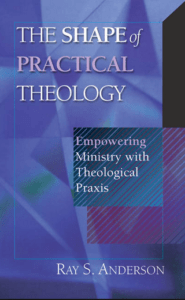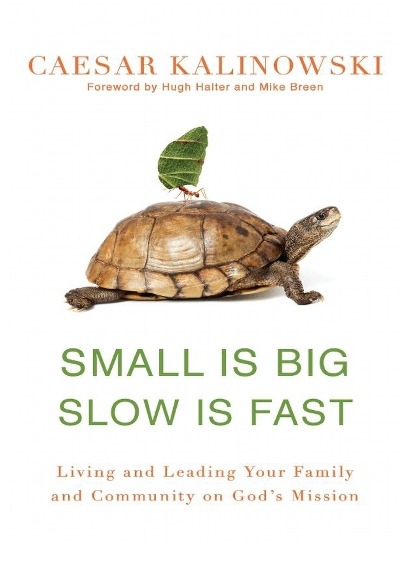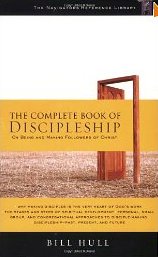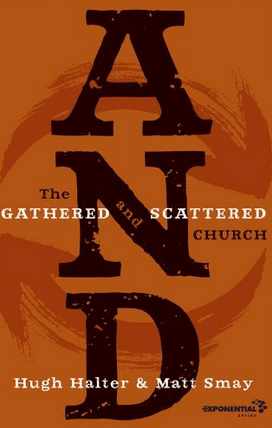by Ray S. Anderson
The subtitle of this book, Empowering Ministry with Theological Praxis, tells the reader that this book is eminently practical, which is what I discovered. Anderson shows that theology can only be developed properly in the context of real life ministry. Theoretical theology, divorced from the complexities of fallen humanity, can lead to some harmful and erroneous positions that fail to demonstrate redemptive love and grace to profoundly flawed people, who have made serious mistakes (sins) in their lives and have reaped the consequences.I have emphasized sentences that are particularly seminal.
Anderson gives us a framework for developing a practical biblical theology that takes into consideration the activity of God’s Spirit in people’s lives, just as Peter and Paul did.
Anderson defines praxis as “truth in action.”
Praxis, then, reveals theology in a very tangible form. In this sense, actions are themselves theological and as such are open to theological reflection and critique. Thus the praxis of the church is in fact the embodiment of its theology… Praxis is an action that includes the telos or final meaning and character of truth. It is an action in which the truth is discovered through action, not merely applied or “practiced.” (p.48-49)
Is this not why Jesus will judge people according to their actions. Actions reveal what we really believe.
The author gives an example from Jesus’ ministry.
When Jesus experienced the work of God through a miraculous healing on the sabbath (John 9), he argued that the truth of the sabbath was to be found in the restoration of humanity, not in keeping the law of the sabbath. When challenged by the Pharisees…, he responded, “The sabbath was made for humankind, not humankind for the sabbath.” (Mark 2:27) This is what is meant by praxis. The work of God in our midst discloses to us the word of God, even as the Word of God reveals its truth producing God’s work. (p.51)
Praxis is not merely a “practice” involving the making of a product or application of theoretical knowledge; it means discerning the truth as final outcome of one’s action. The action itself contains its own good end, and if the end is not “good,” the action cannot be the right one. For example, when Jesus healed on the sabbath, he was acting in accordance with the telos of the sabbath – that is, God’s purpose for the sabbath, reconciliation and restoration of life to its God-intended value. This was praxis. (p.239)
The kingdom of God is revealed through a praxis that embodies the telos, or maturity, or a life through its actions. The New Testament Greek world teleios (mature, perfect) was used by those who translated the Old Testament into Greek (the Septuagint) to render the Hebrew word salem (shalom), which means “sound, complete, whole.” (p.239)
The author argues that theology that is divorced from a critical reflection of God’s actions in the world borders on idolatry.
The continued presence and work of the Holy Spirit constitute the praxis of Christ’s resurrection. This means that the truth of resurrection is not only the fact an historical event but the presence and power of a resurrected person, Jesus Christ… Following Pentecost the early church interpreted the praxis of the Holy Spirit as the continued ministry of the risen Christ… Christopraxis…upholds the full authority and objectivity of the divine word as written in holy Scripture but only because Scripture itself is contingent on the being of God as given to us through the incarnate Word. Should one wish to dissolve the contingency into a Word of God that exists as a sheer objectification of truth detached from God’s being, it would be done at the peril of idolatry, in my judgment. (pp.51-53)
Jesus has not simply left us a set of teachings. He has done that. But in addition, he continues to teach. Discovering this teaching is itself a hermeneutical task, not merely an exercise in historical memory… the resurrected Jesus as the living Lord is a continuing hermeneutical criterion for interpreting the Word of God. (p.84,87)
Practical theology integrates the “objective” truth of Scripture with the actions of the Holy Spirit. If our theology does not account for what the Holy Spirit does, our theology must be altered, lest we become as the Pharisees whose messianic theology could not accommodate Christ and his actions. An easily understood example would be how the doctrine of cessationism fails to account for the present day activity of the Spirit. The choice has to be made between doctrine and the Spirit’s work. How to navigate such a crisis is the theme of this book.
It is a tension between the new humanity and the new order, which is always and already present through the Holy Spirit, and the old order, in which we have received the command of God but which must give way to the new. (p.89)
Where there is a tension within Scripture between the now and the not yet… a proper interpretation of scriptural authority as a rule of faith must take into account the presence and work of the risen Christ within his church. (p.91)
Women in Ministry as an Example of the Need of Practical Theology
Anderson’s book is designed to help us navigate the difficult exegetical waters of some key questions confronting the church, one of which is the role of women in ministry. As I see it, there are three ways to approach this issue. One is to adopt a strict complementarian approach that insists that men hold all positions and roles of authority in the church. On the opposite end of the spectrum are those who hold the egalitarian position that women are free to hold any and every position or role in the church. In the middle are those who think that the Bible generally teaches that men are called to be in authority positions, but women are free to minister in any area and are sometimes called to have authority. What is at issue here are scriptures which seem to clearly teach that women should hold a subordinate role in the church when it come to authority matters posed against Paul’s assertion that in Christ there is neither male nor female. (I am deliberately not including the details of this debate.) Anderson argues the following: since…
New Testament evidence is not unanimous as to teaching forbidding women to exercise pastoral leadership and ministry in the church, the issue cannot be settled on a textual exegesis alone… The situation is not unlike that which confronted Peter. On the one hand he had the Old Testament teaching that God’s gracious election was restricted to the Jews… On the other hand he had the teaching of the Lord himself that pointed toward offering Cornelius and his household full parity in the gospel. The issue was settled for him when the Spirit fell on the assembled people while he was yet speaking. (p.92)
Using this logic, Anderson insists that we must recognize the divine call on women whom God clearly raises up to serve in pastoral ministry.
To refuse to ordain women to pastoral ministry would be to refuse to recognize the freedom of the Lord as manifested through his work…in the church today. (p.93)
Recognizing that the Spirit indeed calls, equips, and places women into pastoral ministry does not do violence to the scriptures that men generally are called to lead and hold authority. What it does is make room for the Spirit to apply a “resurrection reality” to the present time as he may choose. We also have a scriptural precedent in how God raised up Deborah to judge and command Israel, having authority over its leading general.
Circumcision and the Need for Re-examination of Doctrine
The issue of circumcision wracked the early church. The Old Testament clearly insisted that it was a clear and non-negotiable mark of covenant inclusion. When Peter and Paul observed the Holy Spirit fall upon uncircumcised Gentiles, they realized that their theology of circumcision was not in agreement with the Spirit’s activity. Whenever this happens, we are driven to reexamine the Word of God to see if there is something we missed, some scriptural precedent which foreshadowed what the Spirit is doing. This is what Paul did. He realized that God justified Abraham by faith before he was ever circumcised. This gave the apostle the scriptural basis for properly interpreting the present work of the Spirit and gave rise to the doctrine of justification by faith. Paul blended his exegesis of Scripture with the observed activity of God’s Spirit. If we fail to do this, we separate…
the word of God from the work of God, a practice against which the apostle Paul warned in his letter to the Roman church. (Romans 14:20) (p.99)
For Anderson,
Theological reflection must be a “way of seeing” as well as a way of thinking. (p.103)
When Peter defended baptizing in water Cornelius and his family to the resident theologians in Jerusalem,
His defense was not based on clever exegetical reading of the Scriptures but on the compelling praxis of the Spirit revealed through his ministry of witness to the resurrection power of Jesus. (p.104)
What the author is saying is that the Spirit takes what is real in Christ, some of which is yet to be fully revealed in the resurrection, and brings it into our present historical context as he sees fit.
The Spirit that comes to the church comes out of the future, not the past. The presence of the Spirit is the anticipation of the return of Christ. (p.105)
Anderson states:
As nearly as I can see, for every case in which eschatological preference was exercised by the Spirit in the New Testament church, there was a biblical antecedent for what appeared to be revolutionary and new. (p.109)
Furthermore, the Spirit’s eschatological preference always works toward realizing God’s original purpose for humanity. (p.111)
The church is created and recreated through the praxis of the Spirit, liberating it from its conformity to nature and culture and its tendency to institutionalize the Word. (p.112)
In the person of Jesus there was a spiritual integrity that revitalized the spirit of human persons amidst the dead weight of tradition and legalism; where Jesus was there was life… He liberated the spirit from the law and created children of God out of slaves. He lifted the burden of the law by fulfilling it, not by breaking it, and pointed beyond it to a higher fulfillment. (p.169)
Applying these truths, Anderson states:
Where the Spirit of Christ prevails, there can no longer be discrimination based on race, gender, or economic status. (Galatians 3:28) There can be no acts of favoritism…
The church repents by engaging in theological reflection on the work of God’s Spirit under the mandate of God’s Word… The church repents when it brings out new wineskins of worship and weaves new patterns of communal life out of the “unshrunk cloth” of the next generation. (p.182)
If the church is to be the redemptive presence and power in the world that God intends, it will be where the Spirit of Christ crossed the boundary and breaks through the wall that separates us from each other. (pp.185-6)
The church itself should seek to become the church that Christ desires to find when he comes, where distinctions of race, religion, ethnicity, economic and political status, and gender identity will no longer be found in the church and its apostolic life. (p.194)
These are bold words indeed. Clearly this will be the reality of the new creation at Christ’s return. Is the author correct in assuming that the Spirit is working to introduce that future reality into the historical present? I believe so.
Practical Theology as Paraclesis
The third section of the book seeks to apply what has been previously asserted.
The church has tended to stress two forms of the ministry of the Word of God; kerygma, the Word proclaimed; and didache, the Word taught. This leaves paraclesis, the ministry of encouragement or exhortation, to the Holy Spirit. This way of thinking separates the rational form of the Word from the relational. (p.195-6)
Interestingly, since I assume that Anderson is not charismatic, he does not mention that the gift of prophecy also fulfills this aspect of Christ’s ministry of the word – edification, exhortation, and comfort. (1 Corinthians 14:3) These aspects of Word ministry are often associated with the pastoral ministry. Anderson beautifully asserts:
Through the paracletic presence of the Holy Spirit, Jesus himself takes up my cause as his own. (p.197)
This paracletic ministry of Christ through the Spirit does not leave me as an individual but incorporates me into the fellowship of the body of Christ, the missionary people of God. (p.199)
Anderson writes:
A theology that does not begin and end with grace both from God’s side as well as from the human side is a theology that binds “heavy burdens” (Matthew 23:4) and sets a “yoke of slavery” (Galatians 5:1) on those who look for freedom and forgiveness. (p.202)
The litmus test of theology is not only what it says of God but what it does to persons when it is preached, taught, and practiced. (p.202)
The strategy of paracletic ministry in nonnegotiable in terms of advocacy for persons who suffer from discrimination, oppression, and human torment of any kind. (p.203)
The authentic charism that empowers is Christ’s power that redeems humanity from the social, political, and institutional forms of power that dehumanize. (p.204)
Theological Ethics and Pastoral Care
This section deals with how to deal with ambiguity regarding how to uphold the moral law while showing mercy. Anderson asserts:
God’s moral will is directed toward the goal of human life, and his moral laws are given so as to direct us toward that goal. If God himself were present in every case when it appears that moral laws collide, we would instinctively turn to him for assurance as to the best moral decision. This appears to be the way Jesus functioned… [as in the case of the woman caught in adultery]… He assumed that his presence was the presence of the freedom of God’s moral will to become the advocate for the human person. This advocacy clearly did not mean justifying the situation or the immoral actions…, but facilitating the restoration and liberation of the person to realize God’s moral will. (p.219)
Liberation from disease or demons is not an end in itself. Rather, the true end of liberation is the empowerment of the person to stand against prevailing evil [by faith] with a spiritual and moral assurance that she or he is not cut off from God’s moral and spiritual good. (p.227)
Effective liberation, the goal of moral advocacy, is accomplished with the binding of the one who is estranged to the community of those who rest in God’s moral good of forgiveness and community. (p.230)
The way of wisdom is the telos that reaches into the actions (praxis) of therapy to enable the client to establish a coherent meaning to life. This itself can be transforming, even when not every situation can be transformed. There are losses that can only be grieved…The moral law supports moral judgements in such cases. But the moral law does not itself contain wisdom’s freedom to provide healing and restoration… the church… will need to offer restoration and renewal to those who have no moral standing… The tension between upholding the divine order in its perfection and upholding the divine intention in restoring humanity is a praxis of moral wisdom. (pp.241-242)
That last sentence is one of the best thoughts of the book and challenges us to go beyond an intellectual application of rigid orthodoxy and venture into the realm where Jesus ministered, where we learn from the Spirit how to properly apply God’s truth in a redemptive and restorative way whenever possible.




